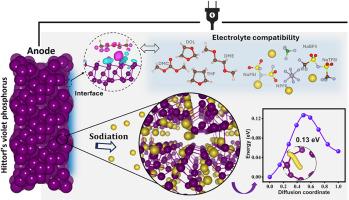揭示单层希托夫紫磷作为一种新型钠主阳极,推动钠离子电池技术的发展
IF 7.9
2区 工程技术
Q1 CHEMISTRY, PHYSICAL
引用次数: 0
摘要
虽然钠离子电池(sib)被广泛认为是锂离子电池最可行的继任者,但由于钠的充足供应和低成本,其进展仍然受到缺乏高效阳极材料的阻碍。在这里,我们利用密度泛函理论和从头算分子动力学模拟,探索了一个新的脱落的二维相的希托夫紫磷(2D VP)作为潜在的钠主阳极。结果证实了二维VP具有能量、动力学和热稳定性。该材料表现为直接半导体,带隙为1.72 eV,吸附多次Na后带隙消失。此外,2D VP表现出较强的Na吸附(- 2.17 eV)和快速的扩散(0.13 eV),有效抑制Na枝晶的形成,并与普通电解质表现出相容性。值得注意的是,2D VP提供了0.62 V的平均电位和618.06 mAh/g的高理论容量,优于几种已知的磷同素异素。我们预计,这些计算筛选的结果不仅将拓宽磷基阳极的前景,而且还将刺激合成和评估用于实际钠离子储能解决方案的2D VP的实验努力。本文章由计算机程序翻译,如有差异,请以英文原文为准。

Unveiling single-layer Hittorf's violet phosphorus as a novel sodium host anode to advance Na-ion battery technology
While sodium-ion batteries (SIBs) are widely regarded as the most viable successor to lithium-ion batteries, thanks to sodium's abundant supply and low cost, their progress is still hampered by the lack of efficient anode materials. Here, we explore a newly exfoliated two-dimensional phase of Hittorf's violet phosphorus (2D VP) as a potential sodium host anode using density functional theory and ab initio molecular dynamics simulations. The results confirm that 2D VP is energetically, kinetically, and thermally stable. The material behaves as a direct semiconductor with a band gap of 1.72 eV, which disappears upon multiple Na adsorption. Moreover, 2D VP exhibits strong Na adsorption (−2.17 eV) and rapid diffusion (0.13 eV), effectively suppressing Na dendrite formation and demonstrating compatibility with common electrolytes. Notably, 2D VP offers an average potential of 0.62 V and a high theoretical capacity of 618.06 mAh/g, outperforming several known phosphorus allotropes. We anticipate that these computationally screened results will not only broaden the landscape of phosphorus-based anodes but also stimulate experimental efforts toward synthesizing and evaluating 2D VP for practical sodium-ion energy storage solutions.
求助全文
通过发布文献求助,成功后即可免费获取论文全文。
去求助
来源期刊

Journal of Power Sources
工程技术-电化学
CiteScore
16.40
自引率
6.50%
发文量
1249
审稿时长
36 days
期刊介绍:
The Journal of Power Sources is a publication catering to researchers and technologists interested in various aspects of the science, technology, and applications of electrochemical power sources. It covers original research and reviews on primary and secondary batteries, fuel cells, supercapacitors, and photo-electrochemical cells.
Topics considered include the research, development and applications of nanomaterials and novel componentry for these devices. Examples of applications of these electrochemical power sources include:
• Portable electronics
• Electric and Hybrid Electric Vehicles
• Uninterruptible Power Supply (UPS) systems
• Storage of renewable energy
• Satellites and deep space probes
• Boats and ships, drones and aircrafts
• Wearable energy storage systems
 求助内容:
求助内容: 应助结果提醒方式:
应助结果提醒方式:


